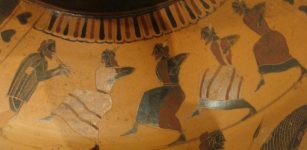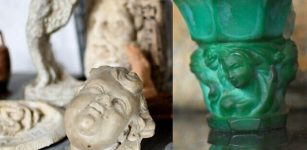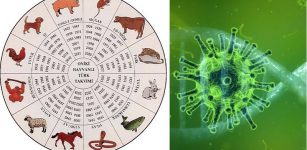Mysterious Undeciphered Ripley Scroll And Its Connection To The Philosopher’s Stone
Jan Bartek - AncientPages.com - One of the most unusual and intriguing alchemy manuscripts is the Ripley Scroll.
The Ripley Scroll, an impressive manuscript that is almost 6 meters in length, provides instructions on the creation of the legendary Philosopher's Stone.
Alchemy And The Philosopher's Stone
Alchemy is typically perceived as an ancient practice that aims to transform common metals into gold by using a mysterious element known as the Philosopher's Stone.
The Philosopher's Stone is a mythic alchemical substance. Credit: Adobe Stock - Anastasia
The so-called "philosopher's stone," a legendary substance believed to have the power to transform common metals into gold and silver, was the holy grail of alchemy from the Middle Ages up until the late 17th century. It was also considered an elixir of life, with incredible healing properties and even the ability to bestow immortality on its owner. Interestingly, despite its name, it may not have been a stone at all but could have been a powder or some other form. It went by various names, including "the tincture," "the powder," or "materia prima."
Mystics held the belief that only pure Goodness can bring about human transformation. Christian theology interprets this as the influence of Christ's Spirit. The Philosopher's Stone symbolizes Christ Jesus in this context, which explains its seemingly unbelievable powers.
Throughout history, many brilliant intellectuals from the Western world have embarked on a journey to discover the philosopher's stone. It is generally believed that this mysterious stone can be created through an alchemical procedure known as The Magnum Opus or The Great Work.
The Ripley Scroll Remains Undeciphered
Around 23 versions of the Ripley Scroll are known to exist. While they differ in size, color, and detail, all of them are based on a lost original from the 15th century.
It is wise to admit that plenty of scientists do not know about the enigmatic Ripley Scroll, but it features many significant alchemy symbols.
George Ripley depicted on the scroll. Credit: Wikipedia - CC BY 4.0
The manuscript derives its name from George Ripley, a medieval canon originating from Bridlington Priory, Yorkshire. This scroll is abundant with cryptic and interesting symbols. However, these alchemical symbols remain somewhat unclear and open to interpretation.
Scholars have tried to understand What motivated the production of the Scrolls in the first place? Whence did the texts originate and how were they selected, combined and illustrated? To what extent did the Ripley Scrolls gain authority and notoriety through association with Ripley?" 1
George Ripley Was One of England's Most Famous Alchemists
Sir George Ripley (c. 1415–1490) was a renowned alchemist whose writings influenced alchemists like John Dee, Robert Boyle, and Isaac Newton.
Did Ripley create the scroll himself? It is an open question historians cannot answer. The scrolls are referred to as Ripley scrolls due to the inclusion of poetry attributed to the renowned alchemist. The illustrations within these scrolls symbolically represent the elusive Philosopher's Stone.
One of several images on the Ripley Scroll. Credit: Wikipedia - CC BY 4.0
According to scholars, “these ‘Ripley Scrolls’ are now prized possessions and rarities in modern collections of alchemica thanks to their unusual format and beautiful illuminations. Their association with Georger Riply, fifteenth-century writer whose name features in the later history of some parts of the corpus around the “Verse”, further accounts for their current popularity. Upon closer inspection, however, the Ripley Scrolls are a confused and confusing set of historical objects.
The origin of these Scrolls may be more recent than Ripley’s lifetime and their association with Ripley is not present in early examplars. Further, they were not intented to be used in separation from other alchemica; the text on the Scrolls (poems from the corspus around the ‘Verses upon the Elixir’) were also circulated in plain manuscript volumes.” 1
What Does The Ripley Scroll Depict?
The Ripley Scroll is full of images and symbols that are difficult to understand.
Upon first glance at the scroll, we are immediately drawn to a prominent figure with a large beard, tightly holding an egg-shaped vase. This character, adorned in a cap or headdress and robe, is most likely representing Hermes Trismegistus. Known as the 'thrice-greatest', Hermes Trismegistus is a legendary figure credited with founding alchemy. He is often associated with Thoth, the Egyptian deity of healing.
The toad and the dragon. Credit: Yale University Beinecke Rare Book and Manuscript Library
Certain symbols, such as hermetic vases, a toad, the dragon, the Bird of Hermes, and the red and green lions, are commonly recognized in alchemy. However, their representation can vary significantly depending on their specific application or context.
The Purpose Of The Ripley Scroll Remains A Mystery
According to Professor R.I. McCallum the application of these scrolls remains largely unknown, with no contemporary descriptions by even John Dee. It has been proposed that the scrolls may have served as a form of advertisement in alchemists' shops, but this theory lacks supporting evidence and seems highly improbable for several reasons.
The length of the scrolls would make them challenging to display, and their current state suggests they were not subjected to extensive wear and tear that would be expected from such usage.
The purpose of the mysterious Ripley Scroll remains an enigma. The manuscript's unique imagery and symbols add to its perplexity. Perhaps only individuals with profound alchemical understanding may eventually unravel the secrets of the Ripley Scroll.
If you enjoyed this article consider becoming a member. Our member section offers a wealth of informative and insightful articles similar to this one. Upgrading to a premium membership gives you access to all our articles, including our library of ancient and unexplained mysteries.
Written by Jan Bartek - AncientPages.com Staff Writer
Copyright © AncientPages.com All rights reserved. This material may not be published, broadcast, rewritten or redistributed in whole or part without the express written permission of AncientPages.com
Expand for references- Timmermann, Anke. "The Ripley Scrolls: Alchemical Poetry, Images And Authority." In Verse and Transmutation: A Corpus of Middle English Alchemical Poetry (Critical Editions and Studies), 113–42. Brill, 2013.
- Stanley Redgrove - Alchemy: Ancient and Modern
- Aaron Kitch. "The 'Ingendred' Stone: The Ripley Scrolls and the Generative Science of Alchemy." Huntington Library Quarterly 78, no. 1 (2015): 87–125.
- McCallum R I. The Ripley Scroll of the Royal College of Physicians of Edinburgh. 1996. Vesalius 2:. 39-49.
More From Ancient Pages
-
 Why Is Europe Called Europe?
Ancient History Facts | Apr 21, 2016
Why Is Europe Called Europe?
Ancient History Facts | Apr 21, 2016 -
 Ördög – Shapeshifting Demon Who Controls The Evil And Dark Forces In The World
Featured Stories | Oct 23, 2019
Ördög – Shapeshifting Demon Who Controls The Evil And Dark Forces In The World
Featured Stories | Oct 23, 2019 -
 Mystery Of The Coal On The Pirate Shipwreck Queen Anne’s Revenge Solved
Archaeology | Apr 13, 2023
Mystery Of The Coal On The Pirate Shipwreck Queen Anne’s Revenge Solved
Archaeology | Apr 13, 2023 -
 Aboriginal Art And Knowledge Unlocks Mystery Of Fairy Circles
Archaeology | Apr 5, 2023
Aboriginal Art And Knowledge Unlocks Mystery Of Fairy Circles
Archaeology | Apr 5, 2023 -
 First Bathrooms Appeared Around 8,000 B.C In Scotland
Ancient History Facts | Dec 11, 2016
First Bathrooms Appeared Around 8,000 B.C In Scotland
Ancient History Facts | Dec 11, 2016 -
 5,000-Year-Old Stone Paint Palette Unearthed In Küllüoba Mound
Archaeology | Sep 9, 2020
5,000-Year-Old Stone Paint Palette Unearthed In Küllüoba Mound
Archaeology | Sep 9, 2020 -
 Dance Was A Gift Of The Gods To Ancient Greeks
Featured Stories | Oct 4, 2021
Dance Was A Gift Of The Gods To Ancient Greeks
Featured Stories | Oct 4, 2021 -
 Spir Mountain Cairns: Prehistoric Ancient Monuments To The Dead In Northern Sweden
Featured Stories | Jan 12, 2022
Spir Mountain Cairns: Prehistoric Ancient Monuments To The Dead In Northern Sweden
Featured Stories | Jan 12, 2022 -
 Little People: Ancient Race That Pre-Dates Native Americans, Celts, And Other Settlers Worldwide
Featured Stories | Aug 29, 2024
Little People: Ancient Race That Pre-Dates Native Americans, Celts, And Other Settlers Worldwide
Featured Stories | Aug 29, 2024 -
 Seven Bronze Age Swords And Large Hoard Of Slavic Coins Found In Germany
Archaeology | Dec 4, 2023
Seven Bronze Age Swords And Large Hoard Of Slavic Coins Found In Germany
Archaeology | Dec 4, 2023 -
 Ancient Irish Practiced Special Burial Rituals Such As Dismemberment Of Bodies
Archaeology | Sep 18, 2017
Ancient Irish Practiced Special Burial Rituals Such As Dismemberment Of Bodies
Archaeology | Sep 18, 2017 -
 Djémila – Lost City Of The Ancient Kingdom Of Numidia
Featured Stories | Jun 28, 2021
Djémila – Lost City Of The Ancient Kingdom Of Numidia
Featured Stories | Jun 28, 2021 -
 Exciting discoveries made by archaeologists in Laconia
News | Aug 25, 2015
Exciting discoveries made by archaeologists in Laconia
News | Aug 25, 2015 -
 On This Day In History: First Experimental Hydrogen-Filled Balloon Reaches A 900m Altitude – On August 27, 1783
News | Aug 27, 2016
On This Day In History: First Experimental Hydrogen-Filled Balloon Reaches A 900m Altitude – On August 27, 1783
News | Aug 27, 2016 -
 Oldest Evidence Of Human Cannibalism Found In Gough’s Cave
Archaeology | Oct 5, 2023
Oldest Evidence Of Human Cannibalism Found In Gough’s Cave
Archaeology | Oct 5, 2023 -
 Underwater Archaeologists Retrieve Over 100 Magnificent Glass Objects at Chengene Skele Bay, Bulgaria
Archaeology | Jul 16, 2024
Underwater Archaeologists Retrieve Over 100 Magnificent Glass Objects at Chengene Skele Bay, Bulgaria
Archaeology | Jul 16, 2024 -
 Thousands Of Spectacular Stolen Ancient Treasures Discovered Hidden In Major Bust
Artifacts | Jan 5, 2021
Thousands Of Spectacular Stolen Ancient Treasures Discovered Hidden In Major Bust
Artifacts | Jan 5, 2021 -
 Puzzling Palpa Lines In Peru Made By The Paracas Culture Are Even Older Than The Nazca Lines
Featured Stories | Jan 2, 2018
Puzzling Palpa Lines In Peru Made By The Paracas Culture Are Even Older Than The Nazca Lines
Featured Stories | Jan 2, 2018 -
 Ancient Calendar Predicted The Coronavirus And Other Disasters In 2020 – History Researcher Says
News | Mar 24, 2020
Ancient Calendar Predicted The Coronavirus And Other Disasters In 2020 – History Researcher Says
News | Mar 24, 2020 -
 On This Day In History: Battle Of Sinop Took Place – On Nov 30, 1853
News | Nov 29, 2016
On This Day In History: Battle Of Sinop Took Place – On Nov 30, 1853
News | Nov 29, 2016




